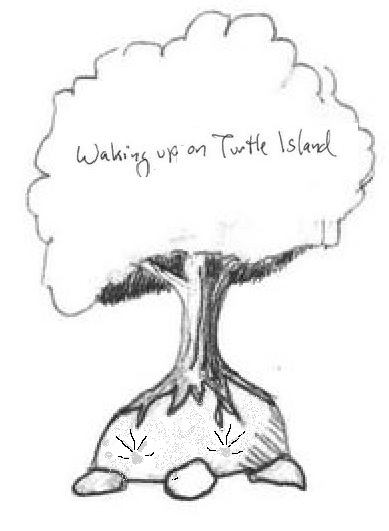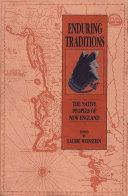
I suppose I should say a little more about the Turtle.
Here's some more old writing from 1998 - with a couple corrections and an addition:
" On a hillside, not more than 1000 feet away from the possible weir, is a “glacial erratic” that seems to me to be humanly enhanced to resemble a turtle shell or carapace. It’s about 2 feet wide and high, about 4 feet long, with separate stones that form a head and partial plastron that this head once rested on, as well as stones that could be the turtle’s feet. Marks on the carapace stone suggest the “sun burst” markings on a box turtle’s shell. They appear to be the size of human hands, carved into the carapace. In the Lenni Lenape Creation Story, it is a box turtle that rises up out of an endless sea. Several animals swimming around the turtle unsuccessfully attempt to dive to the sea floor for some mud to place upon the Great Turtle’s back, until the beaver finally succeeds. As the beaver climbs onto Turtle’s back, he scratches his footprints into the Turtle’s shell and that is why all box turtles have those distinctive markings, the Lenape legend says. I’ve heard the famous “Schagticoke Sisters” from Kent

, CT recall the same legend at various times and places, and was made aware of an Oneida version where it’s muskrat that succeeds and leaves his footprints on the Turtle’s shell by Dr. David Drucker (Email communication 1997). (A
nd by Jim Porter on June 14, 2006, relating that the Narragansett version also has 'muskrat involvement.') I also found it interesting that lithographs of the Oneida Stone in Henry Schoolcraft’s “Indian History” bear great resemblance to this “Box Turtle” sculpture’s carapace stone in western CT.
I found it even more interesting that the stones in the weir resemble turtle

and tortoise shells of roughly the same size and shape as both stones. They are lined up so that every other stone faces east and West, sort of like a row of turtles side by side.

A couple feet from the erratic/turtle is a stone row that also appears to contain more testudinate stones, a sort of “fence of stone turtles.” I suspect this fence was possibly a firebreak for a hilltop food supply, a “mast forest” grove of oak/chestnut/hickory trees. William Cronan, writing in Changes in the Land, mentions that what most impressed the earliest of European visitors to New England was the practice of burning off the forests to create the “parklike” landscape so often mentioned in the pre-epidemic Northeast. Historically, Giovanni de Verrazzano first made note of the openness of the forest in the first recorded visit to the area, reporting smelling burning wood from far off at sea in fact. In 1605 in the “Voyage of George Waymouth,” James Rosier was so impressed with the forest’s appearance that he was moved to capitalization when he wrote, “It all did resemble a Stately Parke.” Cronan points out that the landscape

was not a “virgin wilderness,” but a managed system of Native American land use. In “The Native People of Southern New England” Kathleen Bragdon also writes that “The landscape created by the Ninnimissinouk (a Narragansett derived word for “People” that she uses in the book) in the sixteenth and seventeenth centuries was also one showing visible signs of social and cultural “management.” Native people exercised control over plant and animal species through land clearing, especially in the yearly (some say twice yearly) “burning off” of the undergrowth. She cites Gordon Day writing in 1953 for Ecology 34(2): 329-46, entitled ‘The Indian as an Ecological Factor in the Northeastern Forest’: “Burning increased the food supply for heath hen, passenger pigeon, wild turkey, and deer. The association between certain nut trees such as chestnut at village sites was probably attributed to burning as well.” Cronan believes that these were controlled fires, especially in the denser populations of Southern New England. He also suggests that these matters are best studied locally when trying to form a picture of this Indian Landscape. Locally, well above the floodplain known as “The Weir in the Middle,” where I think once stood groves of oak and chestnut, there are remnants of rows of stones that suggest to me this system of land management. In fact, one of these stones in this "fence" also appears to be a mortar stone. This four-foot diameter stone appears to have a basin worked into it where perhaps acorns (and other nuts) were ground as part of preparation for use as food (Also ground up chestnuts, according to Frank Speck in "Big House Ceremony," act as a fish poison that his Native American informant calls "fish peyote").

A stone fish weir and a mortar stone are among the accepted stone constructions made by Native People of New England. Extensive stone firebreaks and large sculptures are not, but in my “local study” I include them in my view of what the pre-colonial landscape looked like in 'The Fresh Water Fishing Place'."
Tim MacSweeney
Oct. 26, 1998
As a footnote for those who may ask “Why a turtle?” I include this from Frank Speck’s “A Study of the Delaware Big House Ceremony (1931)”:
"THE TORTOISE AS A SYMBOL. --- Outlined in particularly high relief is the tortoise. In the latter creature we have the symbol of life, of perseverance, longevity and steadfastness. As the Delaware patriarch says, “The tortoise is the earth; is life.” In the procession of time and among the elemental nature forces the direction of movement is from east to west, according to Delaware belief. So moves the tortoise with measured pace across the earth and through the Big House, carrying out the mythical allegory. At the end of his journey at the “western door,” meaning where the sun sets at the edge of the earth, night will come to an end as does the ceremony after the twelveth night. Thus the tortoise “brings the ceremony.” His shell in the form of the rattle is carried by the participants who take the part of leaders in the recitations and dances and move in the proper westward direction in the Big House. The saying is, as the ceremony is opened, and after the intervals of pause, “The tortoise is bringing us the worship and we are now ready to touch it again.”
The tortoise, moreover, is “he who carries our mother’s body” - the latter being a metaphor for the earth. The tortoise being a “grandfather” thus becomes more ancient than the earth. The prominence of this mysterious creature in Delaware religious belief has long been noted by writers dealing with the tribe.
As early as 1670 the Delawares are recorded as declaring that all things came from the tortoise, that it brought forth the world, that from it’s back a tree had sprung upon whose branches men had grown, that it had a power and a nature to produce all thing such as earth, and the like; that it brought forth what the supreme divinity wished through it to produce.
Zeisberger mentions the world-flood myth in which it is related that some human survivors took refuge on the back of a turtle whose age was so great that his shell was mossy. And the turtle represents the earth.
His rounded back is to the Delawares the earth dome.
Another indication of a belief in the latent potency of the magical powers of this remarkable creature is met with in the esteem paid to the yellow color-pattern on the upper shell of the animal. Face paint patterns of a dignity appropriate to the men taking part in the Big House Ceremony are copied from these markings. The men wearing these patterns are adopting the symbol of the creature who “carries our mother’s body.”
The creature that typifies the earth bearer designated as taxko/ xkc (fused together) in Delaware, and whose symbol exists in the form of the shell rattle, is the Box Turtle (Cistudo Carolina). This reptile is by the rulings of precise taxonomy not a tortoise but a connecting link between the aquatic turtles, or terrapins, and the terrestrial forms, the true tortoises. For the Box Turtles, of the genus Cistudo, deriving their name from the well known structure of the hinged plastron which permits the animal to withdraw the soft parts of it’s body completely within the protective cover of the shell, have partially webbed feet, which places them nearer to the Turtles than the Tortoises. Yet to distinguish the reptile of Delaware tradition from the semi-aquatic American turtles, I have adhered to the designation of tortoise in the text and discussion.
Perhaps certain remarks offered by the informant will, in conclusion, add something to our idea of another side of the character of this knowing and potent reptile, so important to the religious sense of the Delaware.
“The turtle is in its way an evil thing, yet not so evil as a snake which is controlled by the Evil Spirit and also has human face-paint patterns. The Turtle can hurt human beings. Once a boy caught a water-turtle and turned him on his back. The Turtle got mad; raised himself on his legs stiffly. The Turtle raised himself, and launched himself through the air and struck the boy on his head and nearly killed him. The Turtle has a weapon in the sharp frontal plates.” (Pgs.44-47)
He also adds:
"SYMBOL OF THE TWELVE:
The Delaware also point out the occurrence of thirteen plates in the carapace and twelve in the plastron of all members of the American tortoises and turtles, bordered by the twelve marginal plates on each side. Another evidence in native thought of the tortoise as being a living symbol of the Universe (Pg. 62) ."
And:
"FIRE SYMBOLISM. – Among the spirit-forces of Delaware cosmology, “Our Grandfather Fire” (te/ n dai) is held in high esteem. The adoration of fire, however, is not sufficiently exclusive to justify the Delawares being called pyrolatrists. Fire, as a spirit-force subordinate to the Great Spirit, is an agency of purification and invigoration…To the Delaware ceremonialists the making of new, “pure” fire symbolizes “renewing of life, fresh vigor, the breathing of pure air uncontaminated by latent forces of disease, new and pure influences for life and health.” It is one of the forces to which tobacco is constantly offered, and is an auxiliary to the use of cedar as incense in the act of purification."
Frank Speck in “Delaware Big House Ceremony” 1931 (pg. 47)
 The story is that Gideon Mauwee, or Hungry Bear, was out hunting when he came across the place called Schaghticoke, near what's now Kent, CT.
The story is that Gideon Mauwee, or Hungry Bear, was out hunting when he came across the place called Schaghticoke, near what's now Kent, CT.















 The 1892 map shows an old road that went from the first mill in the area, up into an oak and chestnut forest. The 1955 map shows it as a trail.
The 1892 map shows an old road that went from the first mill in the area, up into an oak and chestnut forest. The 1955 map shows it as a trail. 













